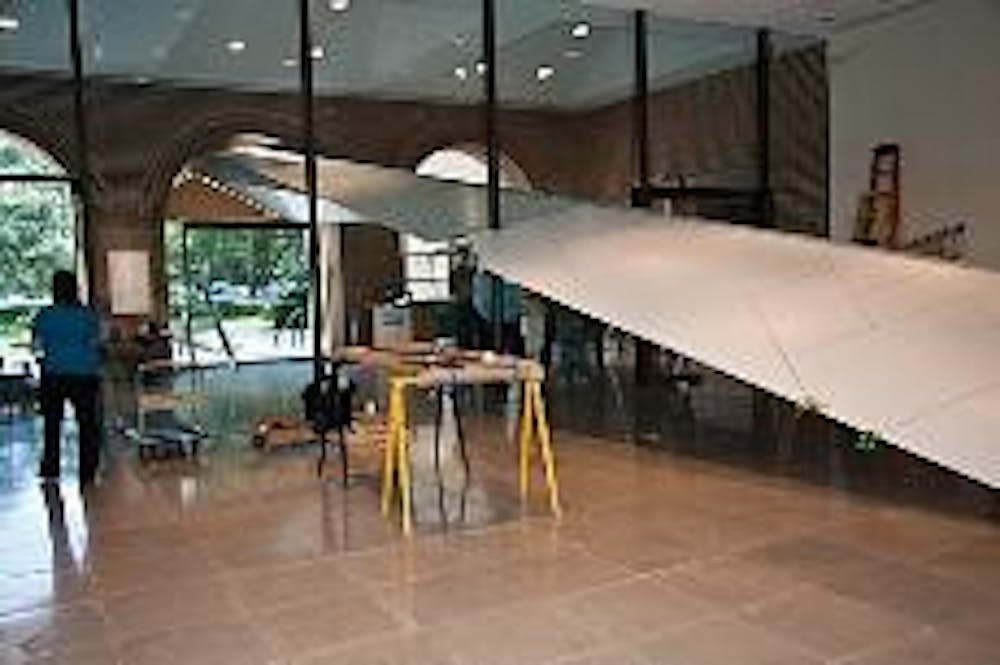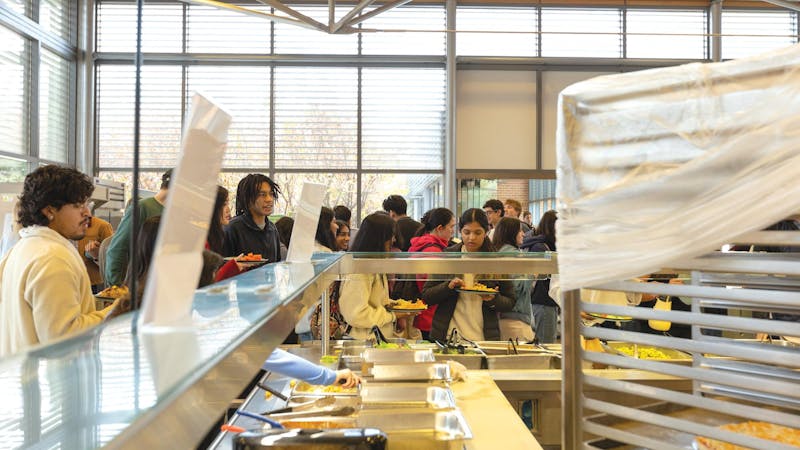Like nothing else you've seen before

"D-17," Sarah Oppenheimer's new installation at the Rice Gallery, reflects her calculated and rational manner. She is not one for frills or excess. She takes her coffee black. She wears a plain blue jumper spattered with paint to work. Her brown hair is reduced to an extremely short buzz cut. She is an artist who relies less on imagination and more on innovation, investigation and academic reasoning. Her piece dominates both the foyer and interior of the gallery: Long sections of white aluminum stretch horizontally back from the middle window of the foyer through the glass panels of the gallery before tapering down to a small point near the back of the interior gallery space. The placement of the aluminum panels forms a tunnel-like passage in the crease of the structure, which allows light from the outside to shine down on the work. The simple and minimalistic streamlined aesthetics of the piece seem especially striking, instilling curiosity and wonderment in the viewer.
The fundamental concepts of space, planes and light interplay within "D-17" to challenge the viewer's assumed perceptions. As a site-specific work, Oppenheimer took advantage of the Rice Gallery's excellent natural lighting and large glass wall when she started to design her installation. The gallery's unique space presented a special opportunity for her to explore the concept of light gradients and how light passes through various surfaces.
The top foyer window and the glass of the gallery act as the major operative planes, which intersect with the horizontal aspects of the work. These planes also double as different permeable filters, allowing light to travel down from a small diamond-shaped hole in the foyer window to the end of the piece in the far back of the gallery. The reflective and slightly tinted surface of the large interior gallery glass window also impacts the pure unaltered light from the outside - the light entering through the hole in the foyer window is not the same quality as the light channeled to the end of the gallery. The different gradients act as various intermediary forces of alteration for the essential element of light within the work.
However, the manipulation of light remains only one aspect of the puzzle. "D-17" seeks to more presently challenge how the viewer interprets the small swatch of tree and sky that the hole in the open foyer window reveals. The diamond-shaped hole defines a view that is, in fact, the same from two seemingly very different points within the gallery - the "D" in the installation's name actually stands for "visual doubling," according to Oppenheimer.
If one viewer stands at a point to the left side of the foyer and another viewer stands about 20 feet behind the other in the recesses of the gallery, they will effectively see the same scene. Even though one viewer appears further away from the foyer window than the other, the reflective and permeable gallery glass alters the light in such a way that the two points look as if they are of equal distance.
Oppenheimer desired the structure to hover through the foyer and gallery space with the movement through the glass [being] continuous and unbroken. The strong horizontal aspect of the work also acts as another perceptual tool of sorts, to challenge how the viewer observes space.
The light passage that cuts down the center of "D-17" transports a thin line of light from the top to the bottom of the piece. The passage creates an including edge, which the body moves around in an attempt to view the scene revealed in the diamond-shaped hole. The shifting view of space makes the eye first try to see higher in the field of vision and then instinctively attempt to see lower in the field of vision as the viewer moves into the recesses of the gallery. Oppenheimer's work is an invariably astounding journey for the viewer's instinctive visual perceptions.
The underlying concepts of "D-17" are more than complex; they are downright mind-boggling. The average viewer has little hope of deciphering the complicated geometric and psychological aspects that coincide to explore the concept of perception and perceived space. Yet, any viewer can marvel at the extraordinary craftsmanship Oppenheimer brings to the work. The simple, smooth white surface and incredible size of the piece form a striking vision piercing out from the otherwise empty space of the foyer and gallery.
"D-17" opens on Sept. 16 and will run through Dec. 5. While it is a work that is a challenge to appreciate for some, it does deserve time and consideration before judgment. Oppenheimer's interest in exploration and innovation find a worthy home at the Rice Gallery, amid such a vibrant and inquisitive student body.
More from The Rice Thresher

Over 1,000 students petition against new meal plan
When Konstantin Savvon opened the Housing and Dining email announcing the new unlimited meal plan, he was instantly concerned about the impact on off-campus students like himself.

Rice football wins season opener under new coach
For the first time since 2018, Rice football opened its season with a victory. Scott Abell was soaked with yellow Powerade following a 14-12 win on the road Saturday against the University of Louisiana at Lafayette, which won 10 games and made it to the Sun Belt Conference championship last season.

Acting like an athlete: Rice basketball alum takes on Broadway
Underneath Chadd Alexander’s Broadway costume, there’s ankle tape and wrist braces — same protective gear he wore as a walk-on basketball player at Rice, though now he’s performing eight shows a week in the ensemble of “Harry Potter and the Cursed Child” instead of running conditioning drills in Tudor Fieldhouse.

Please note All comments are eligible for publication by The Rice Thresher.